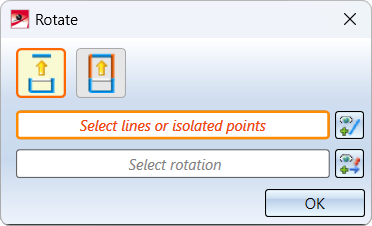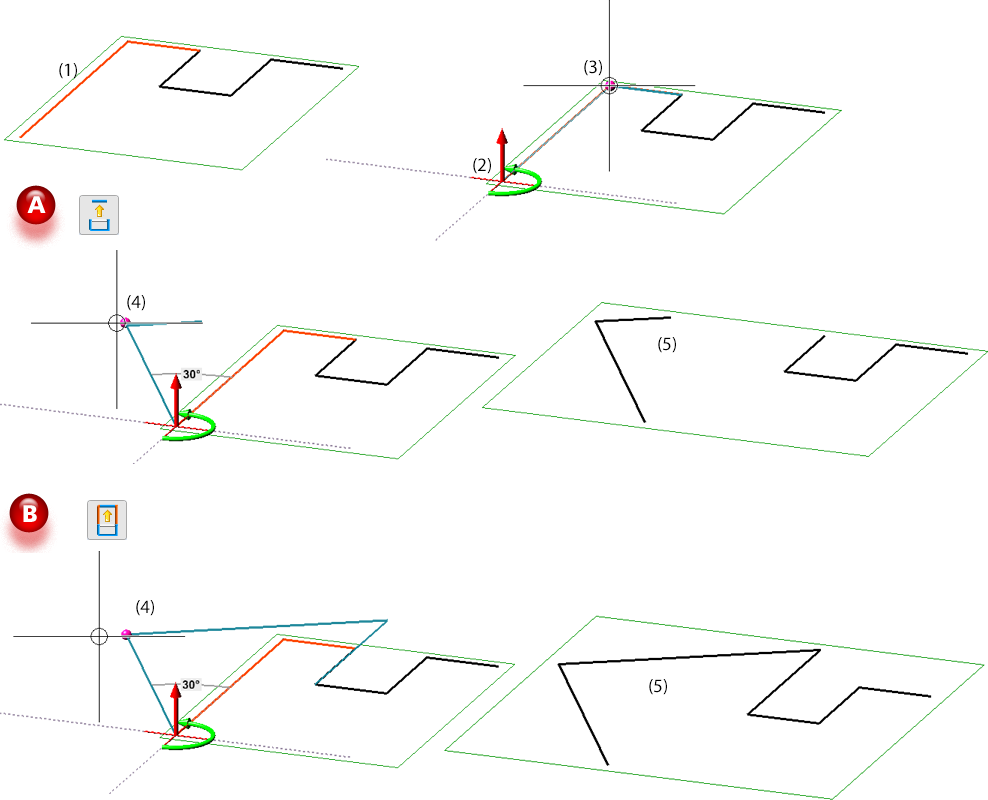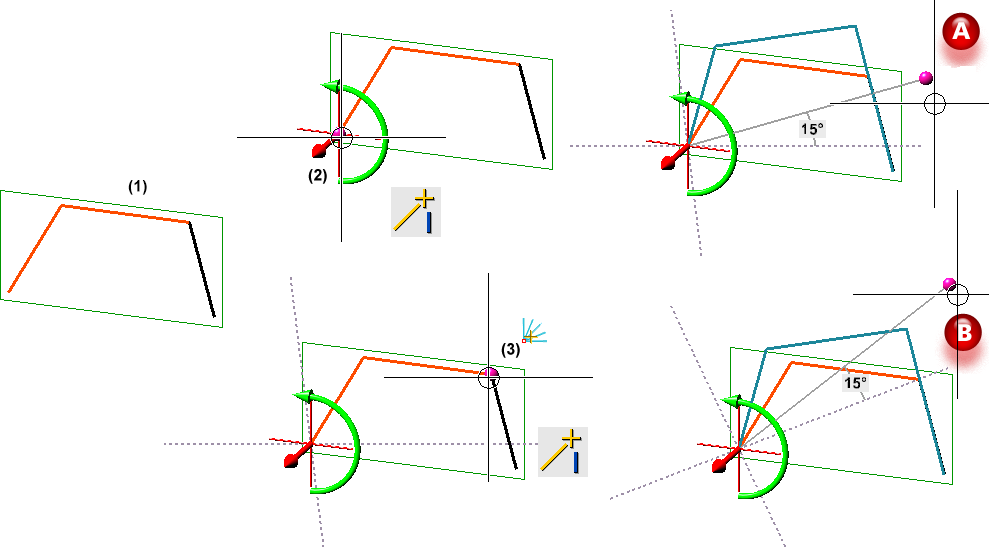Rotate Sketch Elements
Sketch > Transform > Rotate 
Use this function to rotate graphical elements or isolated points of a sketch. When you call the function, the Rotate dialogue window will be displayed:

The currently active step will be highlighted with an orange frame in the dialogue window. After calling of the function these steps consist in the selection of lines or points.
Step 1: Select option
Use the symbols at the top of the dialogue window to specify the handling of connected lines during rotating.
|
|
Rotate lines, individually If this option is active, only the actually selected lines (highlighted red) will be rotated. Connected lines will not be adjusted.
|
|
|
Preserve connected lines and adjust length If this option is active, HiCAD will attempt to preserve the position of the connected lines if possible. In the process, the length of the lines to be rotated may be adjusted by means of new intersections. For distances the angle between connected lines will be preserved. If it is not possible to preserve the connected lines, the
|
Step 2: Select elements
Select the lines or isolated points that you wish to rotate in the drawing, or use the functions of the context menu that you can open with a right-click during the selection process.

|
Connected lines or edges* Use this function to select all lines or edges that are connected to the next identified edge in one step. The lines and edges will be selected up to a point where a continuation would no longer be unambiguous. This function can also be activated with the help of the SHIFT key: If you select a line while holding down the SHIFT key, all connected lines will be automatically selected as well. |

|
Tangentially connected lines or edges* Choose this function if you also want to select all tangentially connected lines or edges when identifying the next line or edge. |

|
Lines and isolated points in rectangle (CTRL+LMB)* Use this function to select lines and points by means of a selection rectangle. Please note that only lines/edges and points of the active sketch will be considered. If the rectangle is drawn from the top left to the bottom right, all lines and isolated points which are completely located within the rectangle will be selected. If, on the other hand, the rectangle is drawn from the top right to the bottom left, lines/points that are only partially located within the rectangle (i.e. lines that intersect with the rectangle) will also be selected. The selected lines and isolated points will be highlighted in colour. You can also call the function via the keyboard. Proceed as follows:
|

|
Cancel (Esc) Cancels the function. |
*Normally, already selected elements (lines, edges and points) will be de-selected if you click them again. For the above functions marked with an asterisk *, however, the following applies: If you click elements that have already been selected or if already selected elements are located in a selection, they will not be removed from the selection.
The selected elements will be highlighted in the drawing and the number of selected elements will be shown in the dialogue window:

Press the middle mouse button to end the selection. Click the  icon to expand the selection.
icon to expand the selection.
Step 3: Determine rotation point/rotation axis and rotation angle
After exiting the line selection, HiCAD first prompts you to select the rotation point. A distinction must be made here between planar sketches and 3-D sketches.
- Planar sketches
You can also select the origin of the active coordinate system as the rotation point by selecting the Origin  function in the context menu after right-clicking.
function in the context menu after right-clicking.
After determining the rotation point, the angle to the X-axis can be determined dynamically with the cursor on an angle grid. By setting down the cursor or selecting a point, the displayed rotation angle is accepted and the rotation is executed.
The angle can alternatively also be determined with the functions of the context menu.
|
|
Angle reference
This function does not determine the rotation angle to the X-axis, but to a line between the rotation point and a second point. The lines between the rotation point and this point will be rasterized and the angle can then be determined dynamically with the cursor. Example: (A) The two lines marked in red (1) are to be rotated. The lower left point is selected as the rotation point. The angle refers to the X-axis. (B) Here, after determining the rotation point, the Angle reference function is called and the upper right point is selected. Now the angle refers to the line between the rotation point and the upper right point.
|
|
|
Value input This function activates the HiCAD calculator. You can then enter the angle explicitly via the keyboard or tap it in the drawing. Instead of calling the function, you can also simply press the space bar. |
- 3-D sketches
Here HiCAD requests the selection of an axis instead of the rotation point after the line selection. This determines the direction of the rotation and can be determined by
- two points,
- an edge or
- a surface. The axis here is the surface normal.
You have the additional option to right-click and open a context menu with further functions for direction specification.
|
|
Origin
|
|
|
X-axis (only for 3-D sketches) |
|
|
Y-axis (only for 3-D sketches) |
|
|
Z-axis (only for 3-D sketches) |
|
|
Step back
|
|
|
Cancel
|
To change the axis, click on the  symbol.
symbol.
After determining the direction, the angle can be determined - analogous to plane sketches. If the Angle reference function is selected here, the perpendicular is rasterized from the selected point to the selected axis. The angle is then referenced to this line.
The rotation point can be changed by clicking on the  icon and then selecting the new rotation point.
icon and then selecting the new rotation point.
As soon as the grid line is displayed, the selected line elements can be rotated on an angle grid by dynamically rotating this line. The value for the angle grid can be preset in the Configuration Editor under System settings > Identification in the Grid area.
After the rotation has been executed, the dialogue window will remain open so that further lines can be rotated directly.
Example of a planar sketch

A: Rotate lines individually, B: Preserve connected lines and adjust length
(1) Selected lines, (2) Select rotation point, (3) Point for angle reference (4) Angle 45°, (5) Result
Example of a 3-D sketch

(1) 3-D sketch; (2) Highlighting of selected elements; (3) Selection of a surface, (4) Point for angle reference, (5) Angle 90°; (6) Result without adjustment of connected lines
![]() Please note:
Please note:
- The selected lines and isolated points must belong to the same sketch. Otherwise, a corresponding error message will be displayed.
- HCM constraints will be adjusted if possible. If an adjustment is not possible, they will be removed.



 symbol will be shown at the
symbol will be shown at the 







